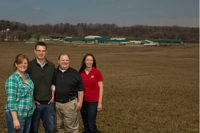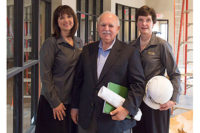One of the primary claims anti-meat activists make against the beef industry revolves around animal handling and welfare. Often, beef processors face significant challenges to maintain better-than-average animal-welfare standards because of outdated, decades-old equipment and facilities.
| Do you think Harris Ranch deserves to be the 2014 Plant of the Year? Vote for them in the National Provisioner 2014 Plant of the Year poll! |
Furthermore, cattle-handling and kill-floor equipment and facilities can be a significant capital investment. Harris Ranch Beef Co., headquartered in Coalinga, Calif., knows the pain all too well when it comes to anti-meat activists — having endured a direct attack from activists in 2012 that destroyed several trucks in its fleet — yet it has not wavered in its commitment to animal welfare.
In fact, it has now helped raise the standard for cattle-receiving and cattle-harvesting facilities.
Handling and harvest, re-imagined
By the time the “Great Recession” hit the economy, Harris Ranch’s Selma, Calif., beef-processing facility was long overdue for a renovation of its kill floor and animal-handling areas, says Brandon Carlson, assistant vice president, Operations, for Harris Ranch.
“Essentially, the justification was to improve animal welfare, food safety and worker welfare, and … protect the brand from any threats, whether animal welfare-related or food safety-related,” Carlson explains.
After weathering the economic storm of 2009, Harris Ranch began upgrading its facilities. First, in April 2011, Harris Ranch rebuilt cattle-receiving pens outside the Selma facility, taking direction from both Temple Grandin and the experts in-house at the company’s feedlot. It features a variety of animal-welfare and food-safety enhancements, from shaded pens to keep cattle out of the hot central California sun, to a spray-washing system that gently washes dust and debris off the cattle before they enter the facility (see the photo on pages 38-39).
In 2012, Harris Ranch turned its focus to the harvest facility. Rather than renovate the harvest floor in piecemeal fashion, Harris Ranch made the decision to dive in, expand and provide a state-of-the-art facility along multiple fronts.
In February 2013, Harris Ranch completed construction on a new building addition that would house a portion of the harvest-floor expansion. In September 2013, the renovation of everything from the cattle pens up to the carcass coolers was complete. The new kill floor covers nearly twice its former floorspace — the area that once housed all harvest and fabrication now features only “hide off” processing. All “hide on” work is done in the new building, giving employees the room they need to do their jobs more easily and efficiently, says Manny Pinheiro, vice president, Operations.
“Working in a 50-year-old plant, [ergonomics] was something our workers didn’t really have prior to the renovation,” he admits. “But now we have given them that, and we have given our customers even more comfort on the food-safety front as well.”
Harris Ranch proudly reports no real operational downtime at any point in the transition, and that most of the work was done during weekends or at night, easing the burden on operations.
“Once we commissioned the new building, it was pretty methodical and everything was planned out pretty well,” Pinheiro explains. “Even with the major start-ups, we never really had any downtime — we’d start off a little slower, but even on the new floor we were back to full production in three days.”
Harris Ranch was able to change over the entire harvest operation in four days’ time. Carlson credits the building contractor with a major assist as far as training goes. Employees had access to the equipment manufacturers and retired former operators of the equipment on the floor during the ramp-up period.
“They worked side-by-side with the employees, and it was certainly instrumental in getting us up to full production as quickly as we achieved it,” he says. As Harris Ranch and its contractor worked through the project, they realized that the center-track restrainer they were installing required a much higher climb for the cattle.
“Before the construction, we were using a traditional, roll-out knock box, but with Grandin’s center-track restrainer design, we had to get the cattle a good eight feet up off the ground to get them into the restrainer,” explains Mike Oliver, project engineer for Harris Ranch. The revised design lengthened the serpentine chute in order to maintain a comfortable slope for the cattle to climb without incorporating stairs. In the end, it was a significant investment in additional concrete, but Harris Ranch made the move with animal handling top of mind.
On the harvest floor itself, worker-safety and food-safety strategies take center stage. Many workstations are raised, allowing the front and rear of the animal to be worked simultaneously (in some areas), and customized lifts and platforms allow employees to make cuts and dress carcasses with less effort than they had on the old floor.
Food safety gets a boost by the fact that employees don’t need to bend or reach to make their required cuts, meaning fewer missed cuts and potential harborage points on the carcass for bacteria.
Room to grow
With this major project out of the way, the Selma plant has moved on to renovation of its offal processing areas and construction of new coolers. Also on the docket is modification of its cooking operations to produce a new line of high-quality products — and to add a significant amount of cooking capacity at the plant.
Adding capacity was certainly on Harris Ranch’s mind when it designed the harvest floor renovations. Much of the primary equipment in the facility was “overbuilt”, and it starts with the center-track restrainer and knock box, which can handle more than twice the speed at which the Selma facility processes cattle, says Oliver.
“It’s built for the future, no question,” he says. “We chose it mainly because it was the best out there — by far the easiest, lowest stress equipment, not only on the animals, but the workers as well.”
Further down the line, the custom-designed hide puller has additional capacity to give.
“The auto hide puller represented a significant capital investment over what would have been done to handle our production speeds,” Carlson explains. “It does such a better job both from a yield perspective and a food-safety perspective: It minimizes cross-contamination and what humans need to do to present that hide to the equipment to be pulled, and it maintains your yields.”
Harris Ranch already has reaped some reward for its foresight in that it has not had to overtax the equipment to maintain its production speeds, Carlson adds.
“Even though we may never achieve how fast the equipment can run, we still believe it was the best thing to make that investment — to see proficiencies [and yields] increase while being able to maintain exceptional food-safety records,” he says.
The new serpentine cattle chute at Harris Ranch’s processing facility in Selma, Calif., was designed to keep the cattle calm and prevent them from balking or vocalizing while making their way to the harvest facility.
Harris Ranch installed a brand new knock box (top photo) using a center-track restrainer system, which keeps the cattle calm and subdued for the operator to properly stun the animal. When outfitting its new harvest and fabrication floors, Harris Ranch installed elevated work stations to improve ergonomics, as well as mechanical lifts (bottom photo) that slowly lower the saw operator as he makes his cut to assist in accuracy, yield and ergonomics.









